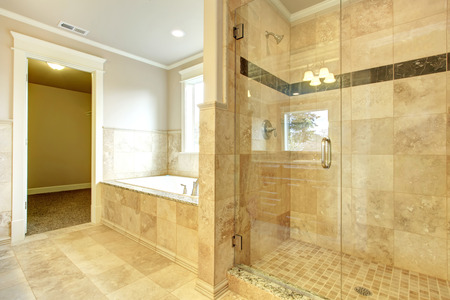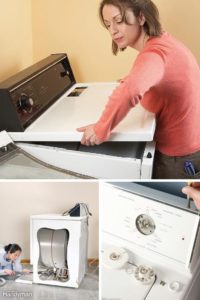Bathroom Remodeling Planning and Ideas for 2018; a detailed Guide to get it right the first time.
Bathroom Remodeling Planning and Ideas for 2018 will walk you thru questions like where to begin, what to buy, how much it will cost or how long will a bathroom remodeling project take? By writing in segments; one week we will discuss cabinets, and the next week tile and so on; you will get “bite” size chunks of information that you can then use to make informed decisions about your project. We will cover such topics as:
- Cabinets
- Tile
- Countertops
- Fixtures
- Faucets and tub/shower valves
- Waterproofing
- Things hidden behind the drywall: exhaust fans, insulation, electrical wiring & plumbing to name a few.
- Lighting
- Medicine cabinets and vanity mirrors.
- Glass surrounds & shower doors
- Towel bars and grab bars
- Doors and trim work
- Painting
And after we have covered all of the material items it will be time to talk about how we go about getting all those things into your new bathroom. With such topics as:
- To permit or not to permit
- Contractors or doing it yourself
- How long will I be without my bathroom
- How much will this cost
- Punch list and job close out – what to expect
- Warranties and the other fine print
After we finish with this blog you should be armed with enough information to go out and make informed decisions about your project. So sit back, and enjoy the read. Don’t forget to follow our blog; Bathroom Remodeling Planning and Ideas for 2018, so you can be notified when the next update hits. As always, if you have a question, feel free to contact me at: Info@sunsetbuilders.net or 239-233-2152. Lastly, I ask for your assistance in providing accurate information. Please let me know if you have an issue with something I have written; it is entirely possible that I could have “old” information as the construction industry is constantly changing itself. My ego is in check and I value all input!
NEW THIS WEEK:
Bathroom Remodeling Planning and Ideas for 2018 – Part 2: Cabinet Selection.
Everything you ever wanted to know about remodeling a bathroom.
MATERIAL SELECTIONS
VANITY CABINETS
One of the first things you notice when you walk into a bathroom is the vanity cabinet and the door styles. Because of its size relative to the entire space the vanity selection offers a great opportunity for you to show off your personality. Vanity cabinets come in many shapes, sizes and colors but they have a few items in common and understanding them will make your selection process much easier.
SIZE
Vanity cabinets can be made to fit any opening size you may have but their are some sizes that are readily available or “stock” sizes as they are known in the industry. Measuring from left to right (the width); stock sizes are 24”, 30” 36” and 48”. You will have no trouble seeing vanities in these sizes at your local box store. Measuring from front to back (depth) you have two “stock” sizes; 18” and 22”. In most cases you will want to go with the 22” depth. The 18” depth is used in powder rooms or very small bathrooms. (NOTE: When you measure your vanity, make sure to measure the cabinet itself and not the countertop. The vanity will typically be shorter in at least one and maybe both dimensions.) Don’t see your size listed in the “stock” sizes? Or, maybe your size is a few inches larger? This is quite common and the apparent problem is solved using “filler” strips which are nothing more than strips of wood finished to match the cabinets that are cut down to the desired width and then mounted onto the side of your vanity to “fill in” the gap between your cabinet and the adjacent wall. For example, the last project we did had a drywall opening dimension of 39-¾” wide at the back right below the vanity mirror (NOTE: make sure to measure the front and the back of the opening and go with the narrowest dimension.). We sold the client a 36” vanity cabinet and a 4” filler strip that we then cut down to the exact size we needed and attached it to the side of the vanity. Viola! Crisis averted.
CABINET STYLE
You only get two choices on this one; all wood or composite. If you go with all wood expect to pay more (anywhere from 20% and up) and expect to special order your vanity cabinet as this is rarely a “stock” selection. All wood, refers to the material used to construct the “box” or cabinet. As the name implies an “all wood” vanity is made with wood products; typically cabinet grade plywood. Composite boxes are made by pressing and heating (then cooling) wood chips or fibers and glue several times in order to create a panel of a specific thickness. Since these panels are never in short supply and manufactures can churn them out at will the cabinets are significantly cheaper than their “all wood” brothers.
Pro Tip: Once the cabinet is installed it would be difficult for the average person to know the difference between an “all wood” or “composite” cabinet. Save some money on this selection and spend it elsewhere.
DOOR/DRAWER STYLE
There are two; a) slab, and b) panel. As the name implies, the “slab” style is a flat panel, typically the same color as the vanity box, with no other distinguishing characteristics. The “panel” style, however, has many alternatives; raised, recessed, shaker and arched just to name a few. For a comprehensive look at door/drawer styles, take a look at this website (https://www.masterbrand.com/get-started/design-your-room/cabinet-101/cabinet-doors).
Pro tip: Avoid buying cabinets that use “foil” type finishes. These finishes tend to fail with temperature change and use.
COLORS AND ACCENTS
The sky is the limit on this one. Your local box stores typically stock what i call the “flavor of the day” colors; right now dark colors or the use of dark accent lines are very popular.
Pro Tip: Avoid fads and trends when making your selections. Fads and Trends come and go (sometimes very quickly) and when they do it can leave your bathroom feeling somewhat “dated” or old. Pick what you like as a bathroom is one of the most used rooms of your home.
Make sure to check back with us as we will be adding to the Bathroom Remodeling Planning and Ideas for 2018 blog. Our plan is to coach you thru an entire bathroom renovation. Questions about something you read? Call me! 239-233-2152 or send an email to: info@sunsetbuilders.net.
NEW THIS WEEK
Bathroom Remodeling Planning and Ideas for 2018 – Part 1: Tile Selection.
Everything you ever wanted to know about remodeling a bathroom.
MATERIAL SELECTIONS

Beige and white bathroom with white roman tub, beige floor tile, Clear frameless shower door
Tile Selection
The use of tiles in renovation projects is all but a foregone assumption, even more so in bathrooms. In our Blog; Bathroom Remodeling Planning and Ideas for 2018 We have categorized the options into four types of tile: 1) ceramic, 2) porcelain, 3) stone and 4) glass. As a prospective remodeler you will also have to decide on colors, shapes, sizes, finishes, textures, and price point. Because there are so many choices out there, I find customers often get confused and frustrated when the time comes to make their tile selections. But this task doesn’t have to be so challenging! In fact, once you know a few basic characteristics of tile you can design your new space in a style that will not break your checking account and look beautiful once its installed. I will also share an invaluable tip at the very end of this section which should save you a lot of time.
Types of Tile
There are four main types of tile; ceramic, porcelain, stone and glass. Let’s take a look at some features and benefits of each type.
CERAMIC
Most have seen ceramic tile, even if they didn’t know it; New York City’s subway tunnels are one of the first visuals that pop into my head when i think of ceramic tile. Ceramic tile is a tile made from clay that has been permanently hardened by heat, often having a decorative glaze. Because of how they are made, ceramic tiles are inherently waterproof, which makes them ideal for use in a bathroom environment (especially shower walls). Tiles in this category are typically the smallest of the three types (usually no larger than 4” x 4” or 6” x6”. They have a tendency to break during the “setting” process and are easy to chip if you drop something on them after installation. Any chip or crack that occurs on this material cannot be repaired and will require the replacement of the affected tiles. Because of their “glazed” finish, ceramic tiles are a great choice for bathroom walls, but as this glazed finish will make the tile slippery when wet, they do not work well floors. Check out this web site for a more comprehensive look at the pros and cons of ceramic tile: http://www.hgtv.com/design/decorating/design-101/the-pros-and-cons-of-ceramic-tile
PORCELAIN
Porcelain tile is ceramic tile. Wait what? Yes, that’s correct. Both products start their lives the exact same way. The notable difference is that porcelain tile is more impervious to water absorption which makes it an excellent choice in bathrooms and kitchens. To be considered “porcelain” a tile must have a water absorption rate of 0.5% (or less) as defined by American Society for Testing and Materials (ASTM) C373. Because of how porcelain tiles are made (fired at extremely high temperatures)and the material they are made from (very dense clay which is strong – and gets even stronger after it is fired), they are very strong and ideally suited for many construction projects around your home. One of the best features of porcelain tiles is that if you chip one the color inside the tile typically matches the color on the outside of the tile making it harder to see the chipped area.
Web site of interest: https://www.thespruce.com/porcelain-tile-vs-ceramic-tile-1822583
STONE
Just as the name implies, tiles in this category are made by cutting up larger, naturally occurring stones into smaller more usable tiles. They come in tradition sizes but can also be custom ordered to any size. CAUTION: Custom sizing a tile order will cause your price point to skyrocket. Because stone is a naturally occuring product the color that you see on the surface goes all the way thru the tile. Chipping a stone tile can be repaired using epoxy resins and sealers. An aspect of this tile that you should be aware of is that each tile must be cut individually. This causes slight (but sometimes noticeable) variations in the size of each tile. But just as the color of the stone tiles will be random in their appearance, so to will be the size. Finally, stone tiles need to be sealed on a fairly regular basis. Stone is porous and if left unsealed will trap dirt particles deep in side that will dull the appearance.
GLASS
Glass tiles are available in a variety of shapes, sizes and colors and because they are made from glass, are inherently water resistant. Glass tiles typically cost more than ceramic, porcelain and most stone tiles when priced by the square foot of coverage. Ironically, they also cost more to install because of special blades that are needed to cut them, special mortars to get them to adhere to the substrate and the additional time required to install them.
Location of Use
With the invention of photo sharing web sites, folks are finding new and creative places (and ways) to install tile. Traditionally, tile has always been found on floors and walls. It is even used on countertops, backsplashes, shower floors and recessed soap niches. Lately, I have seen artist using tiny ceramic tiles to create fabulous works of art. But it does not matter if you are an artist or a first time remodeler, you need to ask (and answer) a few questions before making your “type” selection.
1) Where will this tile be installed?
a) Any tile being installed on a floor in a wet location should have a low “coefficient of friction”. Make sure to tell your sales representative where the tile will be installed and that water may be present.
b) Are freezing temperatures a possibility? This will narrow your choices.
2) How much maintenance will be required after the tile is installed and are you willing to do it?
a) As mentioned earlier, stone tiles must be sealed on a regular basis (based upon the use of the area installed). Stone can also take longer to clean if it has a “textured” surface.
b) Advancements in designs have created grouts that no longer need to be sealed, but these grouts cost more. If you opt to go with the old powder grout be advised you will need to seal it on a regular basis as well.
3) What is my budget?
a) You should have a rough idea of how much you wish to invest in the tiling portion of your project simply because the price per square foot of tile can vary so much. Knowing your limits ahead of time will help narrow the selections. If you don’t know your budget up front, then you should do some research and find out what some typical ranges for tile material and installation might run for your area.
4) Who will be doing the install?
a) If you are the do-it-yourself type and plan to complete the installation on your own, make sure you are aware of the inherent installation problems associated with each type. For instance, glass tiles require a special (read very expensive) blade to cut; porcelain tiles are very hard to cut using a score type cutter; stone tiles can fracture during any phase of the installation (so always order more than you will need). There are many more potential problems that can pop up and tiling is not a project that you should attempt to do if you get easily frustrated. It can also be a messy project when you are first learning to work with the thinset and grout.
MARC’S “NOT-SO-SECRET” SECRET TIP
As I mentioned earlier, there are many websites out there where folks share their ideas by posting photos of their projects. I often find they share very specific information (tile sizes, types and colors) about their projects. Sometimes I use these photos with clients to give them a starting point. I would invest some time into researching these sites and look for projects that caught my eye. It can be a real time saver.
Make sure to check back with us as we will be adding to Bathroom Remodeling Planning and Ideas for 2018 blog. Our plan is to coach you thru an entire bathroom renovation. Questions about something you read? Call me! 239-233-2152 or send an email to: info@sunsetbuilders.net.
The post Bathroom Remodeling Planning and Ideas for 2018 appeared first on Sunset Builders.

 I arrived promptly 15 minutes late for dinner and was surprised to find that mom had invited more guests to the table. As I sat down, one of the guests was explaining to the rest of the table that they would have to go out tomorrow and buy a new dryer because something went terribly wrong with theirs early that day. In an attempt to be polite, I inquired as to the fate of their dryer and was told that in an attempt to “get at” some built up lint in the back of the dryer (you could see it sticking out of those holes) they had decided to remove 3 screws located on the inside of the dryer and on the back of the rotating drum. After the third screw was pulled out the drum “fell” and made a solid “thunk” noise when it came to rest. Realizing something had gone wrong but not knowing exactly what they decided to remove three more screws from the inside of the dryer and on the back of the rotating drum. Once again, after the removal of the third screw the drum fell again only this time it made a much louder “clunk” noise before coming to rest.
I arrived promptly 15 minutes late for dinner and was surprised to find that mom had invited more guests to the table. As I sat down, one of the guests was explaining to the rest of the table that they would have to go out tomorrow and buy a new dryer because something went terribly wrong with theirs early that day. In an attempt to be polite, I inquired as to the fate of their dryer and was told that in an attempt to “get at” some built up lint in the back of the dryer (you could see it sticking out of those holes) they had decided to remove 3 screws located on the inside of the dryer and on the back of the rotating drum. After the third screw was pulled out the drum “fell” and made a solid “thunk” noise when it came to rest. Realizing something had gone wrong but not knowing exactly what they decided to remove three more screws from the inside of the dryer and on the back of the rotating drum. Once again, after the removal of the third screw the drum fell again only this time it made a much louder “clunk” noise before coming to rest.